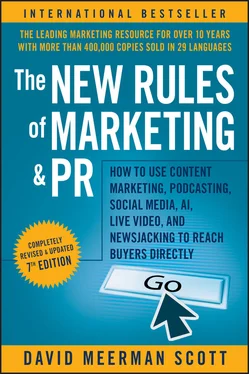Having a social media representative sit on the bridge was originally done on a short-term trial basis, but the benefits to the entire airline became obvious very quickly. The arrangement was made permanent after just a week. “It still amazes me to see something going on at the IOC and the operations manager will turn around and say, ‘What have we seen on social? Is there anything going on?’” Pierce says. “They’re communicating with our team just as much as we’re communicating with them. It’s a really great partnership.”
I went to American Airlines to learn how the airline uses real-time social networking to communicate with customers who tweet cute photos like mine. I wasn’t expecting to learn how important real-time customer communications are for running the entire airline. American Airlines is an amazing example of the new rules of marketing and public relations at work throughout an organization. But it’s not just large organizations that can operate this way. I’ll share many more examples in these pages of companies small and large that are making the new rules work for them, too.
In the following chapters that make up Part II of the book, I introduce social media, blogs, online video, podcasting, content-rich websites, real-time marketing and PR, and artificial intelligence and machine learning. Then Part III presents a guide to creating your marketing and PR plan ( Chapter 10), followed by detailed chapters with how-to information on each technique. Content turns browsers into buyers. It doesn’t matter whether you’re selling premium wine cabinets or a new music CD, or advocating to stop sonar harm to whales, web content sells any product or service and advocates for any philosophy or image.
1 1 zerotrash.org
2 2 facebook.com/ZeroTrash
3 3 century21.com
4 4 chaacreek.com
5 5 belize-travel-blog.chaacreek.com
6 6 bigbirgeplumbing.com
7 7 trinitycleveland.org
8 8 traceylind.com
IIWeb-Based Communications to Reach Buyers Directly
4 Social Media and Your Targeted Audience
As millions of people use the web for conducting detailed research on products and services, getting involved in political campaigns, joining music and film fan clubs, reviewing products, and discussing hobbies and passions, they congregate in all kinds of online places. The technologies and tools, which many people now refer to collectively as social media , all include ways for users to express their opinions online:
Social networking sites like Facebook, Twitter, and LinkedIn help people cultivate a community of friends and share information.
Blogs, personal websites written by somebody who is passionate about a topic, provide a means to share that passion with the world and to foster an active community of readers who provide comments on the author’s posts.
Video and image sharing sites like YouTube, Vimeo, Flickr, SlideShare, and Instagram greatly simplify the process of sharing and commenting on photos, graphic images, and videos.
Chat rooms and message boards serve as online meeting places where people meet and discuss topics of interest, with the main feature being that anyone can start a discussion thread.
Review sites such as Yelp, Rotten Tomatoes, Amazon, and TripAdvisor are places where consumers rate products, services, and companies.
Wikis are websites that anybody can edit and update.
Social bookmarking sites like Reddit allow users to suggest content to others and vote on what is interesting.
Mobile applications with GPS-generated location services add the component of identifying exactly where each user is in the world.
What Is Social Media, Anyway?
Since social media is such an important concept (and is so often misunderstood), I’ll define it:
Social media provides the way people share ideas, content, thoughts, and relationships online. Social media differs from so-called mainstream media in that anyone can create, comment on, and add to social media content. Social media can take the form of text, audio, video, images, and communities.
The best way to think about social media is not in terms of the different technologies and tools but, rather, how those technologies and tools allow you to communicate directly with your buyers in places where they are congregating right now.
Just as a point of clarification, note that there are two terms that sound similar here: social media and social networking. Social media is the superset and is how we refer to the various media that people use to communicate online in a social way. Social media include blogs, wikis, video and photo sharing, and much more. A subset of social media is social networking , a term I use to refer to how people interact on Facebook, Twitter, LinkedIn, and similar sites. Social networking occurs when people create a personal profile and interact to become part of a community of friends and like-minded people and to share information. You’ll notice throughout the book that I use both terms. This chapter is about the larger concept of social media, whereas in Chapter 14we dive into detail about social networking.
I’m fond of thinking of the web as a city—it helps make sense of each aspect of online life and how we create and interact. Corporate sites are the storefronts on Main Street peddling wares. Craigslist is like the bulletin board at the entrance of the corner store; eBay, a garage sale; Amazon, a superstore replete with patrons anxious to give you their two cents. Mainstream media sites like the New York Times online are the newspapers of the city. Chat rooms and forums are the pubs, saloons, cafés, and coffeehouses of the online world. You even have the proverbial wrong-side-of-the-tracks spots: the web’s adult-entertainment and spam underbelly.
Social Media Is a Cocktail Party
If you follow my metaphor of the web as a city, then think of social media and the ways that people interact on blogs, forums, and social networking sites as the bars, private clubs, and cocktail parties of the city. To extend the (increasingly tortured) analogy even further, Twitter can be compared to the interlude when the girls go to the ladies’ room and talk about the guys, and the guys are discussing the girls while they wait.
Viewing the web as a sprawling city where social media are the places where people congregate to have fun helps us make sense of how marketers can best use the tools of social media. How do you act in a cocktail party situation?
Do you go into a large gathering filled with a few acquaintances and tons of people you do not know and shout, “BUY MY PRODUCT!”?
Do you go into a cocktail party and ask every single person you meet for a business card before you agree to speak with them?
Do you try to meet every single person, or do you have a few great conversations?
Do you listen more than you speak?
Are you helpful, providing valuable information to people with no expectation of getting something tangible in return?
Or do you avoid the social interaction of cocktail parties altogether because you are uncomfortable in such situations?
I find these questions are helpful to people who are new to social media. This analogy is also a good one to discuss with social media cynics and those who cannot see the value of this important form of communication.
The web-as-a-city approach is especially important when dealing with people who have been steeped in the traditions of advertising-based marketing, those skilled at interrupting people to talk up products and using coercion techniques to make a sale. Sure, you can go to a cocktail party and treat everyone as a sales lead while blabbing on about what your company does. But that approach is unlikely to make you popular.
Читать дальше












